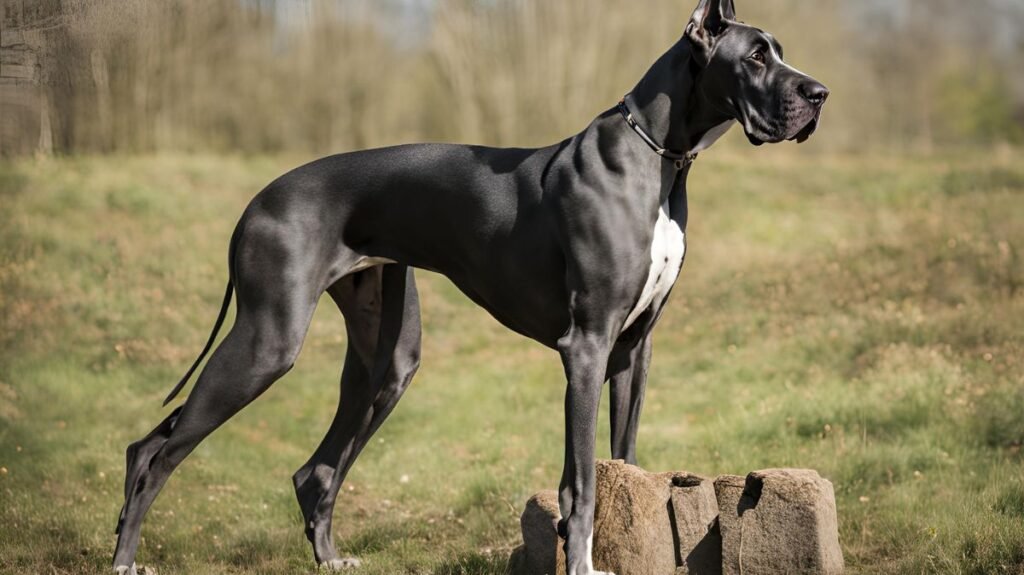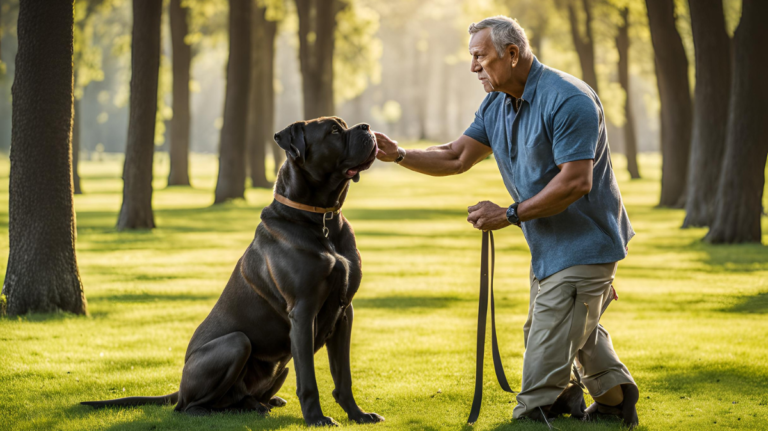Training a Great Dane can be one of the most rewarding experiences with the right approach and knowledge. Known for their great size and even greater hearts, Great Danes require a balanced mix of affection, discipline, and patience during their training. This article will guide you through the essentials of training these gentle giants.

Key Takeaways
| Key Aspect | Details |
|---|---|
| Breed Understanding | Great Danes are known for their size and gentle nature. |
| Training Age | Start training early, ideally as puppies. |
| Training Techniques | Use positive reinforcement and consistency. |
| Importance of Socialization | Introduce them to various environments and people early on. |
| Exercise Needs | Requires moderate daily exercise adjusted for their size. |

Understanding the Great Dane Breed
Breed Characteristics
Great Danes, often referred to as “gentle giants,” are renowned for their imposing size. Yet, beneath that impressive exterior lies a friendly, patient, and reliable companion. Understanding their basic temperaments and needs is the foundation of effective training.
Temperament and Behavior
Notably, Great Danes have a calm disposition, which makes them excellent family pets. However, without proper training, their size can become a concern. You should aim to address behavioral patterns early to avoid any challenges.
Great Dane Puppy Training Basics
First Steps in Puppy Training
When starting with a Great Dane puppy, patience and consistency are key. It’s essential to establish a name they respond to and introduce them to basic commands early on.
- Train with short sessions
- Introduce basic commands like “sit” and “stay”
Establishing a Routine
Regular routines help puppies understand expectations. Set feeding, bathroom breaks, and playtime at consistent intervals to promote security.
“A well-established routine is the cornerstone of disciplined Great Danes.”

Obedience Training for Great Danes
Commands Every Great Dane Should Know
It’s paramount that your Great Dane responds reliably to key commands. Introduce:
- Sit
- Stay
- Come
- Leave it
Positive Reinforcement Techniques
Positive reinforcement, such as treats and praise, create a strong foundation for training. Reward your Dane when they follow a command correctly, establishing a positive association.
| Command | Reward |
|---|---|
| Sit | Small treat and praise |
| Stay | Praise and playtime |
| Come | Affectionate petting |
Potty Training Tips for Great Danes
Indoor vs Outdoor Training
Initially, designate a specific spot for indoor training using pads. Gradually introduce outdoor areas for consistent habits. Outdoor training requires supervision to encourage proper behavior.
Dealing with Accidents
Inevitably, accidents happen. Address these calmly, avoid punishment, and redirect them to the designated spot. This mitigates stress and reinforces learning.
Socialization Strategies for Great Danes
Importance of Early Socialization
Socialization is crucial for a well-balanced Great Dane. Expose them to different environments, sounds, and people to build confidence and adaptability.
Meeting Other Dogs and People
Engage your Great Dane with other dogs and individuals responsibly. Supervised playdates ensure social interactions are positive and beneficial for development.
House Training Your Great Dane
Creating a Safe Space
Creating a safe, comfortable space for your Great Dane is essential. Having a designated area for them within your home, such as a crate or a specific room, can provide a secure place that they associate with rest and calm. This is crucial for effective house training.
- Choose a spacious area
- Include their favorite toys and blankets
Setting Boundaries
Setting clear boundaries will help your Great Dane understand what is expected of them. Using baby gates or other structures can delineate spaces within your home where your dog is and isn’t allowed.
“Boundaries foster discipline, making home life adaptable for both you and your Dane.”

Addressing Great Dane Behavior Issues
Common Behavioral Problems
Some common issues include excessive barking, jumping on people, or pulling on a leash. Recognizing the reasons behind these behaviors can guide you toward the best solutions.
Solutions and Training Exercises
Enrich your training routine with exercises to counter these behaviors. Implement:
- Leash walking sessions
- Controlled greeting practices
| Behavioral Issue | Solution |
|---|---|
| Excessive Barking | Teach a ‘quiet’ command |
| Jumping | Ignore and redirect behavior |
| Pulling on Leash | Practice structured walking |
Importance of Exercise for Great Danes
Developing an Exercise Routine
Great Danes thrive on regular exercise, which helps in maintaining their health and emotional balance. Establish a moderate daily routine that includes walking and play.
- Two 30-minute walks daily
- Indoors play to stimulate mental activity
Mental Stimulation Games
Introduce interactive games to challenge their intellect. Use puzzle toys and brain games that offer rewards as inspiration for ongoing training.
Health and Safety Considerations
Nutrition and Training Impact
Your Dane’s nutrition impacts their training ability. A balanced diet ensures they’re healthy and able to concentrate on training activities. Monitor dietary intake and ensure high-quality dog food.
Health Monitoring
Regularly monitor your Great Dane’s health through vet check-ups. Catch health issues early for continued effective training.
“A well-fed and well-monitored Great Dane is the cornerstone of effective, long-lasting training.”
Advanced Training Techniques
Agility Training for Great Danes
Though less common due to their size, agility training offers great benefits with improved coordination and mental engagement.
Specialized Commands
Further develop your Dane’s repertoire with specialized commands, helpful in advanced obedience contexts.
| Advanced Goal | Training Focus |
|---|---|
| Agility | Basic obstacle courses |
| Special Commands | Unique tricks or tasks |
Maintaining Long-term Training Success
Consistent Training Practices
Consistency is crucial for maintaining your Great Dane’s training over time. Reinforce positive behaviors through repetition and rewards.
Adapting Techniques Over Time
Training isn’t static. Adapt your methods as your dog grows and their needs change. Evaluate current practices annually to ensure effectiveness.
Conclusion
In conclusion, training a Great Dane is a journey that demands dedication and patience. By understanding their unique breed characteristics and implementing structured, positive training techniques, you can nurture a well-behaved and happy companion. Remember, consistency, patience, and love are your best allies in this rewarding process.

FAQ
How early can you start training a Great Dane puppy?
Start training your Great Dane as early as 8 weeks old. Early training helps establish good behavior patterns and disciplines right from the start.
What are the most important commands for Great Danes?
Essential commands include “sit,” “stay,” “come,” and “leave it.” These provide a foundation for control and discipline.
How much exercise does a Great Dane need?
Although large, Great Danes require moderate exercise. Aim for at least 30 minutes of daily walks along with mental stimulation games to keep them active and content.
How much exercise does a Great Dane need?
Although large, Great Danes require moderate exercise. Aim for at least 30 minutes of daily walks along with mental stimulation games to keep them active and content.




